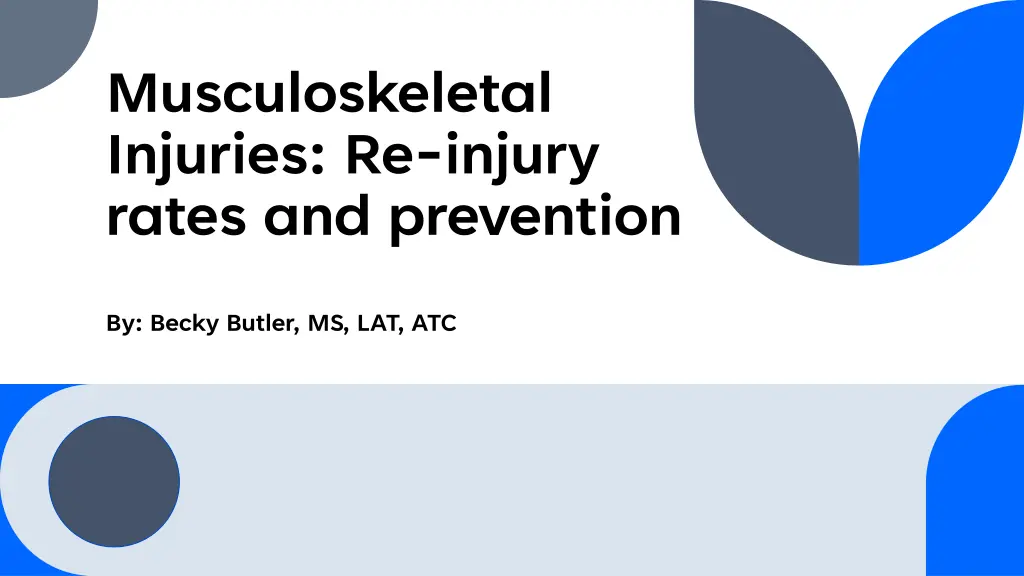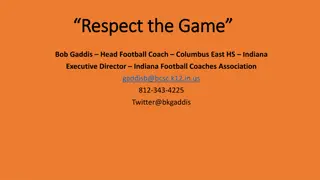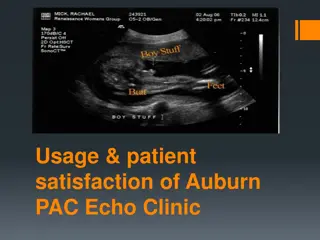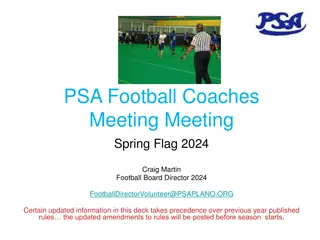
Musculoskeletal Injury Re-Injury Rates and Prevention Insights
Explore the factors contributing to chronic ankle sprains, hamstring strains, patellar dislocations, and effective prevention strategies. Learn about re-injury rates, risk factors, and targeted exercises to enhance musculoskeletal health and reduce the likelihood of recurrent injuries.
Download Presentation

Please find below an Image/Link to download the presentation.
The content on the website is provided AS IS for your information and personal use only. It may not be sold, licensed, or shared on other websites without obtaining consent from the author. If you encounter any issues during the download, it is possible that the publisher has removed the file from their server.
You are allowed to download the files provided on this website for personal or commercial use, subject to the condition that they are used lawfully. All files are the property of their respective owners.
The content on the website is provided AS IS for your information and personal use only. It may not be sold, licensed, or shared on other websites without obtaining consent from the author.
E N D
Presentation Transcript
Musculoskeletal Injuries: Re-injury rates and prevention By: Becky Butler, MS, LAT, ATC
Injuries Chronic ankle sprains Hamstring strains Patellar dislocations Medial elbow instability Shoulder instability Meniscus revision surgeries
Chronic Ankle Sprains 49.3% of ankle sprains occur during athletic activities 73% experience at least 1 recurrent injury 2005-2008 ankle injuries were most common recurrent injury 28.3% in high school sports 30-70% of initial sprains resulted in chronic ankle instability Decreases in range of motion Changes in gait patterns Deficits in dynamic and static balance R.I.C.E Rest, Ice, Compress, Elevate Lace-up braces decrease risk of lateral sprains, but does not completely prevent them
4-way Ankle Bands Heel Raises Neutral, internally and externally rotated Balance Single leg Ground to towel to Dyna disc Y balance Floor taps Catching/Passing a ball SL Agility Ladders Core 4- way ankle Bands Floor Taps Heel Raises Y balance
Hamstring Strains Increased Biceps femoris length Reduced hamstring strength with eccentric and isometric testing Reduced hamstring strength endurance with SL hamstring bridge and eccentric curls High speed running exposure No risk Weight & BMI Flexibility, mobility, and range of motion Risk Factors: Highest Older age Previous hamstring injury Risk Ratio 2.7 (>1 is significant) Previous ACL injury 70% increase in risk rate Previous calf strain 50% increase in risk rate
Quad Sets Hamstring Sets Co-contracts Sets Glute Bridges Single leg Single leg with slides Hamstring Curls Single Leg RDL Hamstring Tantrums Yoga ball or Bands Split Lunges Assisted Pistol Squats with jump Eccentric Hamstring Curls xxxx Glute Bridges Glute Bridge with Slides Quad Sets Hamstring Sets Single Leg RDL https://youtu.be/IHQa- 4aAsxc?si=sLBIFRXJqUlUG sR2 Hamstring Tantrums xxxx Co-Contract Sets Pistol Squat with Jump
Patellar Dislocations 232 subjects, aged 21.2 5.6 15-48% had recurrent dislocations following conservative treatment 45% of recurrent instability had chondral lesions 57.9% of recurring dislocations had chondral lesions Risk factors Patella alta (patella sits high) Dysplasia (abnormal shape) Malalignment syndromes Leg axis deformities More prominent risk with a combo of 2 or more
Quad Sets Leg Extensions Straight Leg Raise With external rotation Add weight Hip Adduction Add weight Monster Walks Forward-backward & Side-to-side Step-Ups Heel Taps4- way ankle Bands xxxx Quad Sets Heel Taps Step-Ups Straight Leg Raise Hip Adduction Monster Walks side-to-side Monster Walks forward-backward
Medial Elbow Instability Non-Operative study Baseball players 42% return to pre-injury level of competition (LOC) Bracing, rehabilitation, PRP injections Operative study 123 athletes; baseball, softball, javelin 33 (30%) above pre-op LOC 64 (58%) same as pre-op LOC 13 (12%) below pre-op LOC Return to sport in 9.8-26.4 months Decrease in velocity and accuracy with throwing athletes Feelings of giving way in grappling athletes Swelling medially with acute, but less so with chronic Chronic overuse may produce decrease extension
Bicep Curls Palm up, thumb up, palm down Triceps Extensions Wrist Strengthening Flexion Extension Ulnar deviation Radial deviation Pronation Supination Bicep Curls Triceps Extension Radial & Ulnar Deviation Pronation & Supination Flexion & Extension
Shoulder Instability Reported rates of instability between 26% and 100% Intrinsic factors Hypermobility Age Extrinsic factors Jobs with overhead activities Collision sports Playing surface 1324 subjects, aged 15-96 Direct blow, falls, assaults, seizures, motor vehicle accidents 44% recurrence in age group 15-40 11% recurrence in age group 40+ 7 studies found men 3 times more likely than women to reinjure 75% recurrent instability following first-time traumatic anterior dislocation 77% of <30 years old had chronic instability due to sport activities Return to daily activity within 6 weeks were 56% likely to have recurrent instability
Pendulums Add weight Scapular Squeezes Banded Wall Walks Shoulder Bands Forward flexion Extension Abduction Internal/External rotation At side to Abducted to 90 Empty/Full can Scapular Squeezes Pendulums Multi-directional Banded Wall Walks Forward Flexion Empty Can Internal/External Rotation Abduction Full Can
Meniscus Revision Surgeries Retrospective review, 2008-2012 293 subjects 324 menisci treated 129 primary repairs 149 partial menisectomies 46 discoid saucerization No risk variables for retears Age, Gender, BMI, Extremity side, Medial vs Lateral tear, Time to repair, Tear location, Associated ligament reconstructions 14 months after initial surgery Majority of failures (83%) within first year 13% had revision surgery 44% debridement 56% repair Overall success rate for arthroscopically managed meniscus repairs in children and adolescence was 87%
Leg Extensions Terminal knee extensions Hamstring Curls 4-way Hip Add weight Monster Walks Forward-backward & Side-to-side Step-Ups Heel Taps Glute Bridges Clam Shells Single Leg RDL Single Leg RDL Step-Ups Clam Shells Heel Taps Monster Walks side-to-side Monster Walks forward-backward Glute Bridge 4-way Hip
Focus Points for Prevention Level of difficulty Weight & Reps Consistency: Once daily Ankle ROM, proprioception, strength, core Hamstring Strength, strength endurance, flexibility, recruitment Elbow Strength, mechanics/techniques Shoulder Strength, mechanics/techniques, posture Knee Strength, proprioception, core
Thank you! Becky Butler 307.315.0735 bbutler@montanabones.com






















